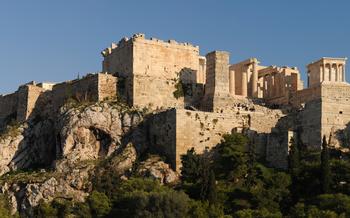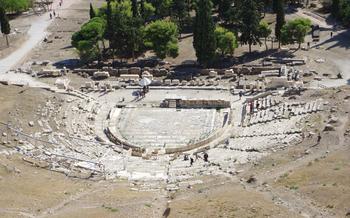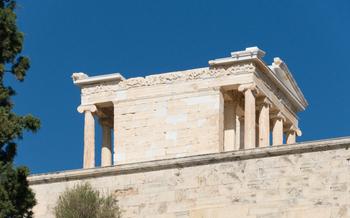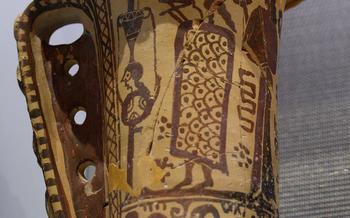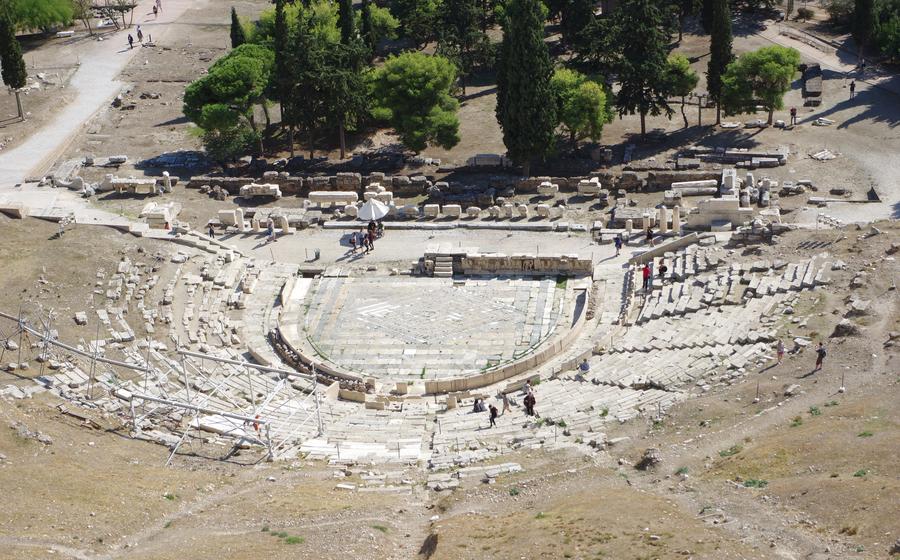
Dionysus Theatre
- The Dionysus Theatre: Antiquity's First and Grandest Stage
- A Walk Through History: Exploring the Theatre's Past
- Architectural Splendor: Unveiling the Theatre's Design
- Acoustics and Stagecraft: The Magic of Ancient Performances
- Tragedies, Comedies, and Beyond: The Theatre's Diverse Repertoire
- The Theatre of Dionysus Today: A Modern-Day Legacy
- Getting to the Theatre: A Journey Through Time
- Tips for Visiting: Making the Most of Your Experience
- Unveiling the Ancient City: Exploring Athens Beyond the Theatre
- Capture the Moment: Photography Tips for Stunning Shots
- Souvenirs and Mementos: Preserving Your Memories
- Safety and Security: Ensuring a Hassle-Free Visit
- Solo Travelers: Tips for Navigating the Theatre Independently
- Insider Tip: Discover the Hidden Gem of the Theatre
The Dionysus Theatre: Antiquity's First and Grandest Stage
The Dionysus Theatre, nestled on the slopes of the majestic Acropolis, is a testament to ancient Greece's vibrant theatrical traditions. Dating back to the 5th century BC, it holds the distinction of being the oldest and largest theatre in the ancient world, capable of accommodating up to 17,000 spectators. Its impressive design, featuring the orchestra, skene, and carefully arranged seating, reflects the architectural prowess of the ancient Greeks. This iconic venue played a pivotal role in shaping the cultural landscape of Athens, hosting renowned playwrights like Sophocles, Euripides, and Aristophanes, whose works captivated audiences and left an indelible mark on the history of drama.
Visiting the theatre was a truly awe-inspiring experience. As I stepped into this ancient marvel, I felt a profound connection to the past, transported back to a time when the greatest minds of antiquity gathered to witness theatrical masterpieces. The sheer scale and grandeur of the theatre were breathtaking, and the acoustics were impeccable, allowing every word spoken on stage to carry effortlessly throughout the auditorium. It was easy to imagine the electrifying atmosphere that must have filled the air during ancient performances, as the audience erupted in laughter, tears, and applause.
A Walk Through History: Exploring the Theatre's Past
The Dionysus Theatre has a rich and storied history, spanning over a millennium. Constructed in the 5th century BC, it was the first and largest theatre in the ancient world, capable of accommodating up to 17,000 spectators. The theatre was not just a venue for entertainment but also a sacred space, hosting religious ceremonies, musical events, and the famous Dionysian festivals, which celebrated the god of wine and theatre, Dionysus.
Throughout its history, the theatre has witnessed countless performances by renowned playwrights such as Sophocles, Euripides, and Aristophanes, whose works explored themes of love, loss, justice, and the human condition. These plays were not just mere entertainment but also served as a means to educate and provoke thought, shaping the cultural and intellectual landscape of ancient Greece.
One of the most fascinating aspects of the theatre's history is its connection to the philosopher Aristotle, who studied at the nearby Academy and is said to have attended performances at the theatre. His observations on the theatre and its impact on audiences formed the basis of his influential work on poetics, which laid the foundation for modern theories of drama and literature.
The theatre's history is not without its share of challenges. It was abandoned in the 6th century AD due to the decline of the Roman Empire and the rise of Christianity, which disapproved of the theatre's association with pagan rituals. The theatre fell into ruin and was rediscovered in the 19th century, sparking a wave of archaeological excavations and restoration efforts that continue to this day.
Architectural Splendor: Unveiling the Theatre's Design
The Dionysus Theatre stands as a testament to the architectural prowess of ancient Greece. Its layout is a marvel of design, with the orchestra, skene, and seating arrangements all contributing to an immersive theatrical experience.
The orchestra, a circular space at the center of the theatre, served as the performance area. It was surrounded by the skene, a building that provided a backdrop for the performances and housed the actors' dressing rooms and storage spaces. The skene also featured a raised platform, known as the proskenion, which extended into the orchestra and provided additional space for the actors.
The seating arrangements were equally impressive, with tiers of stone seats rising in a semicircle around the orchestra. The lower tiers were reserved for dignitaries and officials, while the upper tiers were open to the general public. The theatre's massive size, with a seating capacity of up to 17,000 spectators, speaks to the importance of theatre in ancient Athenian society.
The theatre was constructed using local limestone and marble, materials that have withstood the test of time. The intricate carvings and decorative elements that adorn the theatre's facade and interior are a testament to the craftsmanship and artistry of the ancient Greeks.
Sitting in one of the ancient stone seats, I couldn't help but be awestruck by the theatre's grandeur and the ingenuity of its design. It was easy to imagine the vibrant atmosphere and the roar of the crowd as ancient dramas unfolded on this very stage.
Acoustics and Stagecraft: The Magic of Ancient Performances
The acoustics of the Dionysus Theatre are truly remarkable. The ancient Greeks had an incredible understanding of sound engineering, and the theatre was designed in such a way that the actors' voices could be heard clearly throughout the auditorium, even in the furthest rows. This was achieved through a combination of factors, including the theatre's shape, the materials used in its construction, and the careful placement of the seats.
The theatre also featured innovative stage machinery, which allowed for elaborate set changes and special effects. The ekkyklema, a platform on wheels, was used to bring scenes in and out of the theatre, while the deus ex machina, a crane-like device, was used to lower gods and other characters onto the stage. These mechanisms added an element of spectacle and excitement to the performances.
The actors in ancient Greek theatre wore elaborate costumes and masks. The costumes were often brightly colored and made from fine materials, while the masks were made of wood or leather and were designed to amplify the actors' voices and express different emotions.
I had the opportunity to witness a performance at the Dionysus Theatre during my visit to Athens. The play was Sophocles' "Oedipus Rex," and I was amazed by how the actors' voices carried so clearly throughout the theatre. The performance was also enhanced by the use of stage machinery, which brought a sense of realism and excitement to the production.
Tragedies, Comedies, and Beyond: The Theatre's Diverse Repertoire
The Theatre of Dionysus was not just a venue for tragedies; it also hosted a variety of other genres, showcasing the diverse range of ancient Greek drama. Comedies, known for their humor and satire, were a popular form of entertainment. Playwrights like Aristophanes used comedy to poke fun at politicians, social norms, and even the gods themselves. Satyr plays, a unique genre that combined elements of comedy and tragedy, were also performed at the theatre. These plays often featured mythological characters and explored themes of fertility and the natural world.
Beyond these main genres, the theatre also hosted other types of performances, such as musical events and religious ceremonies. Musicians and poets would perform their works, accompanying themselves on instruments like the lyre or the flute. Religious festivals, such as the Dionysia, were held in honor of the god Dionysus and featured theatrical performances as part of the celebrations.
Each genre and type of performance held at the Theatre of Dionysus played a significant role in shaping the cultural landscape of ancient Athens. Tragedies explored profound themes of human suffering and the human condition, while comedies provided a lighthearted and humorous perspective on society. Satyr plays delved into the realms of mythology and nature, while musical events and religious ceremonies celebrated the arts and honored the gods. Together, these diverse performances created a rich and vibrant theatrical tradition that continues to captivate audiences to this day.
Personal anecdote:
During my visit to the theatre, I had the opportunity to watch a performance of Sophocles' tragedy, "Oedipus Rex." The play's exploration of fate, free will, and the consequences of one's actions left a lasting impression on me. The powerful performances of the actors and the evocative use of the theatre's acoustics brought the ancient story to life, creating a truly immersive experience.
The Theatre of Dionysus Today: A Modern-Day Legacy
Despite the ravages of time, the Theatre of Dionysus remains a vibrant and dynamic space, continuing to honor its ancient legacy through a variety of modern-day performances and events. The theatre has undergone extensive restoration and preservation efforts, ensuring its survival for future generations.
The theatre's stage has once again become a platform for artistic expression, hosting plays, concerts, and cultural events throughout the year. These performances range from classical Greek tragedies and comedies to contemporary works that draw inspiration from the theatre's rich history.
The theatre also serves as an educational hub, offering workshops, lectures, and guided tours that delve into the history, architecture, and significance of ancient Greek drama. These programs provide visitors with a deeper understanding of the theatre's cultural and artistic legacy.
Attending a modern-day performance at the Theatre of Dionysus is a truly immersive experience. As the sun sets over the Acropolis, the theatre's ancient stone seats come alive with the sounds of actors' voices and the melodies of traditional Greek music. The audience is transported back in time, experiencing the magic and wonder of ancient Greek theatre in a setting that has remained virtually unchanged for centuries.
Getting to the Theatre: A Journey Through Time
The Theatre of Dionysus is nestled on the slopes of the Acropolis, offering breathtaking views of Athens and its ancient landmarks. Getting to the theatre is an adventure in itself, taking you through the heart of the city's historical center.
To fully immerse yourself in the experience, I recommend walking to the theatre. As you stroll along the cobbled streets, you'll pass by charming cafes, souvenir shops, and remnants of ancient history. The walk is a gradual incline, but the stunning views of the Acropolis and the surrounding hills make it worthwhile.
If you prefer a more convenient option, taxis are readily available and can take you directly to the theatre's entrance. The ride offers a glimpse into the vibrant streets of Athens, with its bustling markets and lively atmosphere.
For those with limited mobility, there are accessible transportation options available. The Acropolis Metro Station is a short walk from the theatre and provides step-free access. Additionally, there are designated parking spaces for visitors with disabilities.
No matter how you choose to arrive, the journey to the Theatre of Dionysus is an integral part of the experience. It's a chance to soak in the city's energy, marvel at its ancient wonders, and prepare yourself for a journey back in time to the birthplace of theatre.
Tips for Visiting: Making the Most of Your Experience
To fully immerse yourself in the ancient ambiance of the Dionysus Theatre, plan your visit carefully. The best time to visit is during the shoulder seasons (April-May and September-October) when the weather is pleasant, and the crowds are smaller. Aim to arrive early in the morning or late in the afternoon to avoid the midday heat and capture the golden light for stunning photographs.
For a deeper understanding of the theatre's history and significance, consider joining a guided tour. Knowledgeable guides will provide insights into the theatre's construction, performances, and cultural impact. Pre-booking your tickets online is recommended to avoid queues, especially during peak season.
Dress comfortably and appropriately for the weather, as the theatre is mostly exposed to the elements. Comfortable shoes are essential for navigating the uneven terrain and stone steps. Remember to bring a hat, sunscreen, and water to stay hydrated, especially during the summer months.
Unveiling the Ancient City: Exploring Athens Beyond the Theatre
While the Dionysus Theatre stands as a testament to ancient Greek culture, Athens offers an abundance of other captivating attractions that transport visitors back in time. A short stroll from the theatre lies the majestic Acropolis, a UNESCO World Heritage Site and the heart of ancient Athens. Ascend the sacred hill to marvel at the architectural wonders of the Parthenon, the Erechtheion, and the Temple of Athena Nike.
Venture beyond the Acropolis to discover hidden gems like the Ancient Agora, the birthplace of Athenian democracy. Explore the ruins of temples, stoas, and government buildings, and immerse yourself in the vibrant atmosphere of ancient Athenian life.
For a deeper dive into Greek history and culture, visit the National Archaeological Museum, home to an awe-inspiring collection of artifacts from across the country. Gaze upon the exquisite sculptures, pottery, and jewelry that reveal the artistic mastery of ancient Greek artisans.
To experience the essence of modern Athenian life, wander through the charming neighborhoods of Plaka and Monastiraki. These vibrant districts offer a delightful mix of traditional tavernas, quaint cafes, and boutique shops, inviting you to savor the flavors and hospitality of Greece.
As you explore Athens beyond the Dionysus Theatre, you'll uncover a city that seamlessly blends the grandeur of its ancient past with the vibrancy of contemporary life.
Capture the Moment: Photography Tips for Stunning Shots
The Theatre of Dionysus, with its ancient architecture and stunning views of Athens, presents a treasure trove of photographic opportunities. To capture the theatre's essence, plan your visit for the golden hours of dawn or dusk when the soft, warm light bathes the theatre in a magical glow. Experiment with different camera settings to highlight the intricate details of the stone carvings, the sweeping curves of the seating tiers, and the panoramic views of the city. Explore various angles and compositions to create dynamic images that convey the theatre's grandeur and historical significance. Don't forget to play with the contrast between the ancient ruins and the modern cityscape to add depth and visual interest to your photographs.
Souvenirs and Mementos: Preserving Your Memories
Visiting the Theatre of Dionysus is an experience that stays with you long after you leave. To preserve your memories of this incredible place, you may want to purchase a souvenir or memento to take home. There are several shops near the theatre where you can find a variety of items, including books, postcards, replicas of ancient artifacts, and traditional Greek handicrafts.
If you're looking for something truly unique, be sure to explore the local markets in Athens. Here, you'll find a wide range of souvenirs that reflect Greek culture and craftsmanship, such as handmade jewelry, pottery, and leather goods. Bargaining is expected in these markets, so don't be afraid to haggle with the vendors to get a good price.
As you shop for souvenirs, keep in mind the size and weight of your items, especially if you're traveling with limited luggage. You may also want to consider the durability of your purchases, as some items may not withstand the rigors of travel.
Personal Anecdote:
During my visit to the Theatre of Dionysus, I purchased a beautiful ceramic replica of a Greek mask. I was drawn to its intricate design and the fact that it was handmade by a local artisan. Every time I look at it, I'm reminded of the incredible experience I had at the theatre and the rich history of ancient Greek drama.
Safety and Security: Ensuring a Hassle-Free Visit
Visiting the Dionysus Theatre in Athens is generally a safe and enjoyable experience. However, as with any tourist destination, it's essential to take basic safety precautions to ensure a hassle-free visit.
First and foremost, be aware of your surroundings and keep an eye on your belongings. Avoid carrying large sums of cash or displaying valuables openly. It's also advisable to make copies of important documents, such as your passport and visa, and leave the originals in a secure place at your hotel.
Be cautious of common tourist scams, such as people trying to sell you overpriced souvenirs or offering unsolicited services. If someone approaches you in an overly friendly manner or tries to distract you, it's best to politely decline and walk away.
In case of an emergency, there are several resources available to assist you. The local police station is located a short distance from the theatre, and you can reach them by dialing 100. There are also several tourist assistance offices in Athens where you can seek help or report any incidents.
By following these simple safety tips, you can focus on enjoying the ancient wonders of the Dionysus Theatre without any worries.
Solo Travelers: Tips for Navigating the Theatre Independently
Exploring the Dionysus Theatre as a solo traveler offers a unique opportunity for self-reflection and a deeper connection with the ancient site. Embrace the freedom to set your own pace, wander at will, and soak in the atmosphere without distractions. However, it's essential to plan your visit carefully to make the most of your experience. Research the theatre's history, key features, and performances to enhance your understanding and appreciation. Consider joining a guided tour to gain insights from knowledgeable experts and meet fellow travelers. While solo travel can be incredibly rewarding, it's important to stay vigilant and take precautions to ensure your safety.
My personal experience as a solo traveler at the Dionysus Theatre was both empowering and enriching. The solitude allowed me to fully immerse myself in the theatre's atmosphere, imagining the grandeur of ancient performances and the emotions of the audience. I found myself drawn to a secluded corner of the theatre, where I discovered an ancient inscription that seemed to speak directly to me. This hidden gem became a symbol of my journey, reminding me that even in the midst of a bustling crowd, there's always space for personal discovery and connection with the past.
Insider Tip: Discover the Hidden Gem of the Theatre
Beyond the main stage and seating areas, the Dionysus Theatre holds a hidden gem that often goes unnoticed by visitors. Tucked away in a secluded corner of the theatre, you'll find a small, unassuming altar dedicated to Dionysus, the Greek god of wine and patron of the theatre. This altar, believed to date back to the 5th century BC, is a poignant reminder of the theatre's ancient origins and the deep connection between Dionysus and the performing arts.
As you approach the altar, you'll be struck by its simplicity and elegance. Carved from a single block of marble, the altar features intricate carvings depicting scenes from Greek mythology and the life of Dionysus. The altar's weathered surface bears witness to the passage of time, adding to its charm and historical significance.
Take a moment to sit near the altar and soak in the atmosphere. Imagine the ancient Greeks gathering here to pay homage to Dionysus and to celebrate the power of theatre. Let the tranquility of the surroundings transport you back in time, connecting you with the spirit of ancient Greece.
This hidden gem is a reminder that the Dionysus Theatre is not just a historical site but also a place of profound spiritual significance. It's a place where the sacred and the profane intertwined, where the gods were invoked, and where the human spirit soared on the wings of imagination. Discover this hidden gem, and you'll discover a deeper connection to the theatre's past and a greater appreciation for the enduring power of the performing arts.

